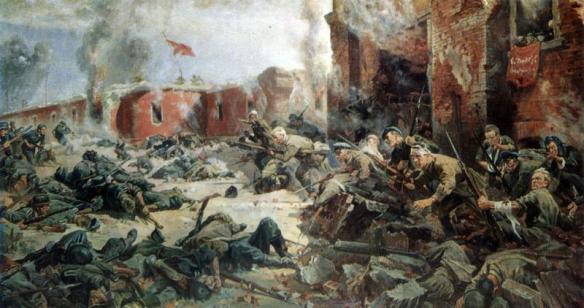
During the opening phase of World War II Kiev was defended by troops of the Southwestern Front commanded by M. P. Kirponos. The German offensive of the “South” army group was commanded by General-Fieldmarshal G. Rundstedt. The initial battles in the western part of Ukraine took place between June and the beginning of July, during which the Germans broke through the Russian defenses and captured Zhitomir and Berdichev. A huge gap was opened between the Soviet Fifth and Sixth Armies. By 10 July the German Third Motorized Corps reached within fifteen kilometers of Kiev. The German sixth Army then initiated an offensive with up to fourteen divisions, of which two were tank and two were motorized.
The Kiev garrison at the time was composed of the Kiev Fortified Region, which contained five machine-gun battalions. This was quickly reinforced by three rifle divisions, two airborne brigades, cadets of the Kiev artillery schools and other units and detachments. While the city inhabitants prepared defensive lines, during July 10 to 16 troops of the Fifth and Sixth Armies launched counterattacks that managed to divert at least eleven German divisions. The Fifth Army, operating from the Korosten Fortified Region, temporarily cut the highway west of Zhitomir. Meanwhile heavy fighting continued close to the city along the highway from Zhitomir to Kiev. On July 11th the German 13th Panzer Division unsuccessfully attempted a crossing of the Irpen River to enter Kiev. On the 13th the German main attack south of Kiev was also stopped. The Germans were forced to turn their attention to eliminating the threat posed to their own flanks by the Soviet Fifth, Sixth and Twenty-sixth Armies. By 30-13 July they were successful in pushing the Fifth and Twenty-sixth Armies back.
The defense of Kiev proper was supported by over 200,000 civilians who volunteered to join the Red Army. A local militia was created. Each day over 160,000 civilians worked on the defensive fortifications. Three defensive lines were developed, an anti-tank ditch 25 km long was prepared along with mine fields and barbed-wire entanglements and 700 field fortification blockhouses were constructed.
The next German attack, which started on 1 August, was aimed to the southwest of Kiev. By 5 August the Germans were able to create a very narrow penetration to reach Chabany, and on 8 August they reached the southwestern suburbs of Kiev. The Soviet command reorganized the defenders into a 37th Army to which they added two more rifle divisions and three airborne brigades. The new 37th Army then counterattacked and by 16 August forced the Germans back practically to their initial positions.
During August the main German attack by the “Center” army group north of the Pripet Marshes continued toward Moscow. Hitler then ordered part of this army group to turn south. The German Second Panzer Group and Second Army then attacked the Soviet defenders of Ukraine from the north toward Konotop, Gomel, and Chernigov, all well to the east of Kiev. By September the Germans reached the Desna River. The command of the southwestern Front wanted to withdraw to avoid immanent encirclement, but Stalin refused. He replaced Budennii with Marshal Timoshenko on 13 September. On September 12 the Germans launched a new offensive from Kremenchug and by September 15th the advance units of this force linked up with troops coming from the north. This encircled the Soviet 21st, Fifth, 37th, and 26th Armies around Kiev. Permission to withdraw was finally given on 17 September. The 37th Army left Kiev on the 19th. But many Soviet troops were captured or killed in the encirclement, including M. P. Kirponos, M. A. Burmistenko and V. I. Tupikov.
Although they ultimately were unable to hold Kiev, the troops of the Southwestern Front did delay the German advance for over two months, forced the diversion of many divisions to the south and contributed mightily to the ultimate German defeat before Moscow.